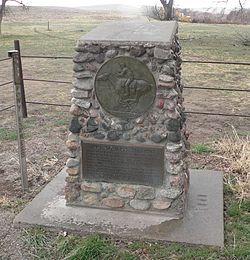The Mud Springs Virtual Reconstruction recreates the appearance of an Overland Trail stop and telegraph station in Morrill County, Nebraska over several days in February 1865. The Mud Springs Station was the center of an armed conflict between troops of the United State Army and Cheyenne, Sioux, and Arapaho warriors. The fight was one of a number of clashes that followed the November 29, 1864 massacre at Sand Creek in Southeaster CO and represents an early phase in the Indian Wars. Native American warriors attacked Mud Springs on February 4 to capture horses and cattle that were corralled there. The small detachment of cavalry soldiers at the Station telegraphed for help and maintained a defensive posture. Troops from other posts hurried to their aid. By February 7, nearly 200 soldiers, several wagons, and even a small cannon had arrived. With that force, the advantage shifted to the Army and Native Americans broke off the fight. In an effort to document the site and understand the tactics used by the opposing sides, UNL and National Park Service (Midwest Archeology Center) archaeologists completed systematic metal detection, geophysical survey, firearms identification, and terrain analysis of the battlefield. This analysis shows that well-armed Native fighters used terrain to approach U.S. troops. When numbers shifted in their advantage, U.S. soldiers dug a rifle pit on the hill to the south of the Station. This vantage point gave them a distinct advantage since it let them see approaching attackers. This digital reconstruction draws on archaeological discoveries as well as historic accounts and geophysical research to visualize the conditions that developed during this engagement. There was little snow during the winter of 1865, but on this wintry day, Mud Springs was probably a cold spot. The reconstruction makes it clear that the Station had become a crowded and well-armed facility. Many questions remain to be answered about the Mud Springs fight. But this reconstruction offers a sense of what life was like for soldiers at the Station. Researchers can also use the reconstruction to predict and interpret discoveries at the site.
Click Here to download the current version of the virtual reconstruction (Windows only at the moment). Instructions on opening the program are below:
1) Unzip/extract all files in the zipped file into the same location in a folder or on your desktop.
2) Double-click the MudSprings.exe file to open the reconstruction launcher program.
It is recommended to run the program in a window, and if you are using an older desktop or laptop, to set the quality settings to fastest.
To move to the next scene/slide, press 'M' on the keyboard. To move to the previous scene/slide, press 'N' on the keyboard.
When transitioning from one scene to the next, allow some time for the program to load.

